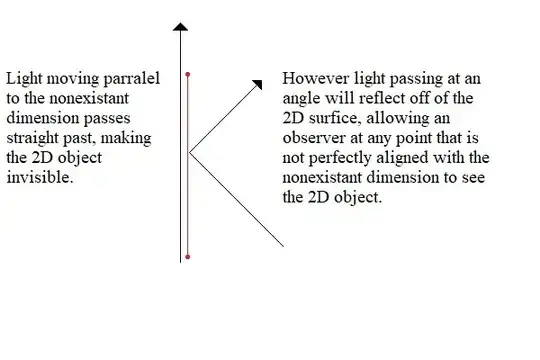The existence of these creatures is scientifically ill-defined, but under rather-generous assumptions which might enable their existence, the answer is an unequivocal "yes".
Like much else from the fantasy Doctor Who (which pretends to be, and is sometimes regarded as, "science fiction"), the "science" of things-that-live-in-shadow really isn't, but you tagged this science, so I have to do my best. There's a continuum here with science-based, and in-particular, we need to discuss the scientific properties of the Vashta Nerada before we can talk about how to scientifically observe them.
First, your assumption that the Vashta Nerada must be 2D is incorrect.
To respond to your first numbered item:
- The 3D space above a cast shadow is not "less dark". The "light field" (or light flowing through every point) varies mostly continuously, except at surfaces (since some photons reflect). Because of this reflected light, and the fact that most surfaces scatter light at least somewhat diffusely, the shadowed area is typically brighter than the so-called "shadow volume" above it.
However, the darkest parts of objects are usually their back-facing surfaces or crevices. E.g., the undersides of a table, not the floor underneath it. So, while these regions are not 2D, we expect to find the Vashta Nerada squeezed inside them.
Second, the larger issue is that what you mean by "shadow" is poorly defined.
In reality, everything is a light source (that's how your eyes work, after all, by absorbing light from them). Your pants are a light source, lighting up the room with pants-colored light.
(If you think there is some difference between an object reflecting light versus an object emitting light (there isn't; the photons don't care), consider that every single atom in the whole universe emits some light.)
The idea of a "shadow" is really just an anthropocentric way to describe the path-length-1 occlusion of a particularly bright light source—and, because of this, nothing is truly "dark" in a physical sense, and few things are "dark" even in a visible-light sense. Consider that you can still make out the carpet inside your shadow, and that you are not peering into a seemingly infinite abyss blacker than space itself.
Defining a better Vashta Nerada
The properties here are really quite fantastic. Presuming that creatures like this exist, they must be able to anticipate where shadows will be, teleport as shadows are created or destroyed, and shrink or grow to adapt to shadow changes. Therefore, they must be quantum energy be—(nope, I'm sorry, you do the handwavium).
Pre-cognitive self-teleportation is effectively a god-power, for reasons that should be obvious, so we have to nerf it. Say, make them just really, really fast. They can also abide some light, or else they couldn't exist at all, let alone hunt inside everyday shadows.
Since size-change is hard to do without violating Physics, having them small in the first place is obvious. Maybe rodent- or grasshopper-sized. Which of-course makes them likely less-threatening to humans. Maybe they can poison you, but they're less likely to be able to outright eat you whole.
Now that we've placed some limits on what the Vashta Nerada are, we can start to reason about how to observe them.
Observing a Vashta Nerada
And the answer turns out to be really simple. Observing a Vashta Nerada is as easy as looking toward it. All shadows contain some light; for most shadows this is even visible light. Since true super-absorbers do not exist, the Vashta Nerada must reflect some light, which you could then see. Q.E.D.
For more creative approaches, try trapping one. Entice it into a nice, dark metal flask. Then close it up and turn on an interior light. This procedure happens so often in industry that it's astonishing we've never seen one before.
Or lure it into your car and drive it to Bonneville Salt Flats before sunrise. Or make a shadow under a cardboard box, then set the box on fire—instant fried Nerada, ready for dissection.
If I were actually imperiled by such a creature, I might head outdoors. If it's a cloudy day, I won't cast a shadow (or, more accurately, the proximate light source is the gray sky, not the Sun, so my shadow is diffuse enough that it appears nearly light). The Vashta Nerada would be forced to remain in the building, which I would subsequently nuke from orbit.

